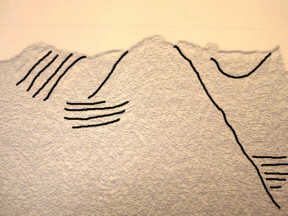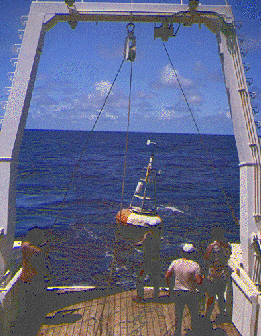BACKGROUND:
The bottom of the oceans is rich in
deposits of sediments with some economic importance. In some areas
of the ocean they mine for lime, sand, and gravel that are used in
the concrete industry. In other areas the oil industry may find oil
reserves.
However, we must look at the ocean bottom
differently than if we are looking on land. The water distorts our
view and we must use indirect methods to look at the floor of the oceans.
There are many different techniques used in underground or undersea exploration
and prospecting. They can take indirect pictures of the seafloor
by using seismic techniques. This allows energy waves to penetrate
an area and then a geologist will interpret the pictures that are derived
from this method.
A core sample is a roughly cylindrical
piece of subsurface material removed by a special drill and brought to
the surface for examination. Coring devices helps to recover samples
of fine-grained deposits on the seafloor in such a way as to preserve the
depositional history through time. By studying the mineral grains, microfossils,
and water in the pore spaces, scientists have been able to infer the past
oceanic events.
PROCEDURE:
- This lab looks at the features of the
ocean floor. Remind the students that it is very difficult to know what is
down there. First students will look at echo soundings and seismic records of
the bottom of the oceans. These help scientists look at the surface of the
ocean and to look at the structure of the rocks.
-
EXERCISE I.
Echo sounding devices use an
instrument similar to that used when a doctor looks at a baby in a mother's
womb by giving an impression of the surface of the ocean floor (topography).
The breaks in each of the pictures are just a consequence of the system. Echo
soundings are taken when an instrument from the ship makes a noise which is
then recorded on the ship when the sound "bounces" back from the
bottom.

The picture is a seismic profile. This gives the scientist more detail of can
be found on the bottom and can be read by geologists to determine what kind of
rocks are down there. A seismic profile uses different types of
"waves" to look at the rocks below the surface.
- Students should look at
different components of the ocean bottom. Students will determine that some of the
materials that you find underneath the oceans are similar to what we see on
land. Some of the samples are not really from the location because of cost
factor. However the manganese nodules and pillow basalt displays are the real
substance. The material was obtained from the U.S. Geological Survey.
EXERCISE II.
 Marine geologists determine what can be found on the ocean
floor by taking dredge samples. A dredge sample is obtained by
"scraping" up parts of the ocean floor using a crane-like device.
This is not very scientifically correct or standard, but it helps. There are
many other ways to look at the bottom of the oceans. The samples used in this
lab are dredge samples from various parts of the ocean. The main objective is for students to recognize the
oceans contain many things.
Marine geologists determine what can be found on the ocean
floor by taking dredge samples. A dredge sample is obtained by
"scraping" up parts of the ocean floor using a crane-like device.
This is not very scientifically correct or standard, but it helps. There are
many other ways to look at the bottom of the oceans. The samples used in this
lab are dredge samples from various parts of the ocean. The main objective is for students to recognize the
oceans contain many things.
- The samples in your module include:
Bahamas. Whole shells and broken up shells, mixed together with some small rock pieces;
light brown in color, some plant matter. Used as sand in concrete.
Manganese
"crusts" found west of Hawaii in the Pacific Ocean. The sample
is large to small (brown-brown, yellow) rock pieces; some pieces look like coal.
Used for manganese, cobalt, and nickel.
Monterey Canyon, off of
Moss Landing; in California is a canyon deeper than the Grand Canyon
The sample is medium to
large grains of sand, black minerals and pink minerals. The Monterey Canyon is
so deep that it is not mined, but the sand could be used in the concrete
business.
East Pacific Ocean, near Hawaii is
where these pillow basalts were found. Your specimen is only pieces
of large boulder basalts that form when magma oozes up from the ocean
floor and cools quickly. There is a shiny outside surface which is
obsidian and had first contact with the water and cooled first. The
basalt would have cooled later.